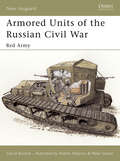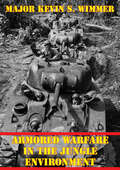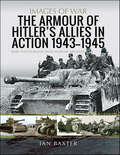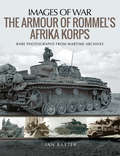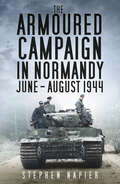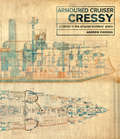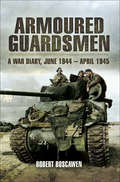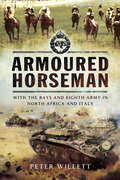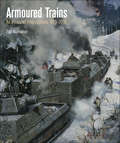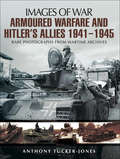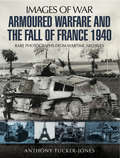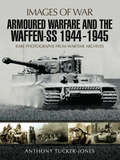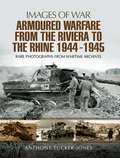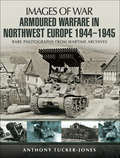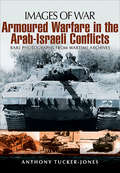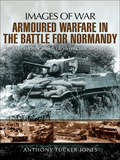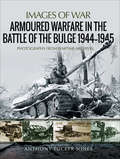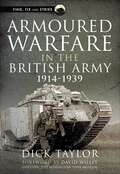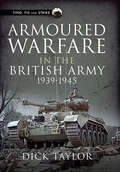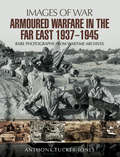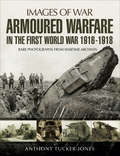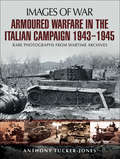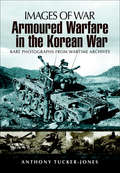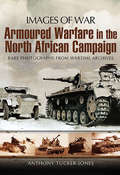- Table View
- List View
Armored Units of the Russian Civil War
by David Bullock Peter SarsonBy 1920 the Red Army fielded an overwhelming array of armored cars and armored trains, while tank detachments had begun forming in earnest. These armored units played an important part in consolidating the newly won Bolshevik empire in the early 1920s; as a consequence of the fact that railways were the strategic arteries that essentially controlled Russia, armored trains have never played such a significant role in military history as they did in the Russian Civil War. This title details their management, construction and repair, personnel and training and combat on all fronts, as well as discussing Trotsky's armored train, in which he conducted 36 tours.
Armored Warfare In The Jungle Environment
by Major Kevin S. WimmerThis study examines armored warfare in a jungle environment. The focus is to determine if there is a role for ground mounted armored forces in jungle warfare. This study explains how armor was used in past jungle conflicts and examines current doctrine and applicability of employment of armor in the jungle.The first portion of the research focuses on discerning how armor was used in past jungle conflicts. The Pacific campaign of World War II and the Vietnam War are examined to determine the historical role of armor in a jungle environment. Early employment of armor in these two conflicts is examined to determine the criteria for use of armored forces in the jungle and examines the tactics, techniques, and procedures that were developed during these conflicts.The second portion of this study focuses on the feasibility of current employment of armor in a jungle environment. Current Army and Marine armored doctrine is examined and interviews are conducted to determine if current armored systems could and should be employed in jungle warfare. Additionally, officers from foreign countries are interviewed to determine how armored forces are employed in the jungle areas of their countries.
Armour and Masculinity in the Italian Renaissance
by Carolyn SpringerDuring the Italian Wars of 1494 to 1559, with innovations in military technology and tactics, armour began to disappear from the battlefield. Yet as field armour was retired, parade and ceremonial armour grew increasingly flamboyant. Displaced from its utilitarian function of defense but retained for symbolic uses, armour evolved in a new direction as a medium of artistic expression. Luxury armour became a chief accessory in the performance of elite male identity, coded with messages regarding the owner's social status, genealogy, and political alliances. Carolyn Springer decodes Renaissance armour as three-dimensional portraits through the case studies of three patrons of luxury armourers, Guidobaldo II della Rovere (1514-75), Charles V Habsburg (1500-58 and Holy Roman Emperor from 1519-56), and Cosimo I de'Medici (1519-74). A fascinating exposition of male self-representation, Armour and Masculinity in the Italian Renaissance explores the significance of armour in early modern Italy as both cultural artefact and symbolic form.
The Armour of Hitler's Allies in Action, 1943–1945: Rare Photographs From Wartime Archives (Images of War)
by Ian BaxterWhile much has been written about the Nazis’ panzers, comparatively little is known about the armored vehicles in service with the other Axis armies. This classic Images of War book redresses the balance by covering in detail the equipment operated by these nations supporting Hitler’s war machine. Using rare and often unpublished photographs with full captions and authoritative text, it provides a comprehensive coverage of Romanian, Bulgarian and Hungarian tanks and other armored fighting vehicles. In addition, it describes Yugoslavian, Serbian and Slovakian armor in addition to armor originating from the Fatherland. Examples of tanks and assault guns are the Romanian TCAM R-2 (Panzer 35t tank destroyer), TACAM T-38 (Panzer 38t), the Bulgarian Jadgpanzer 38(t), StuG40 Ausf.G, Pz.Kp.IV AusH and the Hungarian StuG.III Ausf.G, not forgetting Tigers & Panthers. As well as giving technical specifications, the book traces the fighting record of these vehicles between 1943 – 1945. It shows how armored units fought bands of partisans, and were used to defend their frontiers against the overwhelming might of the Red Army, until they were either captured or destroyed.
The Armour of Rommel's Afrika Korps: Rare Photographs From Wartime Archives (Images of War)
by Ian BaxterThe Deutsche Afrika Korps (best known as simply Afrika Korps) built up a well-deserved reputation as a superb fighting machine. While this was founded on the leadership and tactical genius of its legendary commander Erwin Rommel and the fighting skills of its officers and men, another vital element was its equipment in general and armor in particular. This superbly illustrated Images of War book reveals the full range of German armored vehicles that saw service in North Africa over the two year period 1941 to mid-1943. As well as the formidable panzers , such as the Tiger and Panther tanks, there were Sturmartillerie equipments, reconnaissance vehicles, half- tracks, armored cars, Panzerkampwagens and motor cycles. All had their roles to play. While the Allies triumphed in North Africa ultimately, the combination of German design and engineering with superb generalship and fighting spirit, very nearly changed the course of the Second World War in 1942. Military historians and equipment enthusiasts will find this a fascinating and authoritative book.
The Armoured Campaign in Normandy: June - August 1944
by Stephen NapierBEGINNING with the D-Day landings, this is a brutally frank appraisal of the planned use and actual results of the deployment of armour by both German and Allied commanders in the major tank battles of the Normandy campaign, including operations Epsom, Goodwood, Cobra and Totalize. The Armoured Campaign in Normandy is a critique of Montgomery’s plans to seize territory and break out, and describes how they failed in the face of German resistance. It details the poor planning and mistakes of British senior commanders and how the German Army’s convoluted chain of command contributed to their own defeat; these were decisions taken which costthe lives of the tank crews of both sides ordered to carry them out. Offcial reports, war diaries, after action reports, letters, regimental histories, memoirs of generals and recollections of tank men are used to tell the inside story of the campaign from an armour point of view, to give a different but detailed perspective of the Normandy campaign from the men who fought in it.
Armoured Cruiser Cressy: Detailed in the Original Builders' Plans
by Andrew ChoongThe complete set of builders’ plans for the Royal Navy’s Victorian era armored cruiser famously sunk during WWI.The builders of British warships created a highly detailed set of plans for each ship upon completion. These highly detailed, multicolored drawings represented the exact appearance and specifications of the ship as it entered service. Today, the National Maritime Museum and Seaforth Publishing are making these invaluable resources available to the public through a series of books featuring high-quality digital reproductions.This volume presents the plans for the armored cruiser HMS Cressy. Launched on December 4th, 1899, it best known for the disaster of September 22nd, 1914, in which Cressy and two sister-ships were sunk by a small submarine. Though obsolete by the First World War, Cressy-class cruisers were innovative ships in their day.In full color, with many close-ups and enlargements, these plans make every aspect of the HMS Cressy clear and comprehensible. Extensive captions point the reader to important features to be found in the plans, and an introduction covers the design’s background.
Armoured Guardsman: A War Diary, June 1944–April 1945
by Robert Boscowan&“A rare treat: a well-written account of what it was like to serve as a junior rank in the Brigade of Guards during the Second World War.&” —The Guards Magazine The outbreak of World War II brought many changes to Britain&’s Brigade of Guards. The dress-parade units had always maintained a full combat capacity and made a relatively easy transition into a new unit, the Guards Armoured Division. The Guards landed in Normandy on 26 June 1944 and steadily fought their way across northern Europe. Robert Boscawen was a tank commander in the 1st Coldstream Guards and had four tanks shot from under him. On the fourth occasion he was badly wounded and burned, making a difficult postwar recovery. The years after the war, however, also brought both business and political success, culminating in a twenty-three-year career in Parliament. Boscawen&’s account of Britain&’s elite at war is based on his wartime diaries. &“Tells the author&’s story in a most readable yet matter-of-fact way. It is one of the finest accounts of armoured warfare that I have ever read and I have no hesitation in recommending it to anyone who has not.&” —Tank Regiment Magazine
Armoured Horseman: With the Bays and Eight Army in North Africa and Italy
by Peter WillettA veteran with the Queen&’s Bays in the British Army recounts service during World War II and his career in horse racing post-war. New memoirs by combatants in the Second World War are sadly rare today due to the passage of time. Armoured Horsemen will be warmly welcomed as the author, now into his 90s, fought through with The Bays from Alamein to Tunis and then on up Italy until VE Day. As a young tank troop commander his chances of survival were slim and tragically many of his friends were killed. Peter Willett, a professional journalist and prolific author, is superbly qualified to describe his war and the experiences of his fellow cavalrymen. He tells a moving story with characteristic lightness of touch and modesty. As well as satisfying the military enthusiast, Armoured Horseman will find a ready audience in the racing fraternity. Peter describes equestrian activities in post-war Austria and goes on to summarise his career as a racing journalist, authority on breeding, membership of the Jockey Club and long association with Goodwood.Praise for Armoured Horseman &“Overall this is a rather entertaining description of life in a unit at the heart of some of the most significant events of the Desert War.&” —History of War &“This new book covers familiar ground, because there have been many books that tell the story of the major North African and Italian campaigns, but it brings forward a unique story that is fascinating, compelling and charming. This is a must read WWII account but it will also appeal for its horse racing connections and the very human story that it tells.&” —Firetrench &“What a truly wonderful book! I almost felt I was there and realised that between all the horrors of war there were also some better times and great friendships recounted so brilliantly. It should be made into a film!&” —Nicola Howard-Jones
Armoured Trains: An Illustrated Encyclopedia, 1825–2016
by Paul MalmassariThe military was quick to see the advantages of railways in warfare, whether for the rapid deployment of men or the movement of heavy equipment like artillery. From here it was a short step to making the train a potent weapon in its own right a mobile fort or a battleship on rails. Armed and armored, they became the first practical self-propelled war machines, which by the time of the American Civil War were able to make a significant contribution to battlefield success. Thereafter, almost every belligerent nation with a railway system made some use of armored rolling stock, ranging from low-intensity colonial policing to the massive employment of armored trains during the Russian Civil War. And although they were somewhat eclipsed as frontline weapons by the development of the tank and other AFVs, armoured trains retained a role as late as the civil wars in the former republic of Yugoslavia.This truly encyclopedic book covers, country by country, the huge range of fighting equipment that rode the rails over nearly two centuries. While it outlines the place of armored trains in the evolution of warfare, it concentrates on details of their design through a vast array of photographs and the authors meticulous drawings. Published in French in 1989, this highly regarded work has been completely revised and expanded for this English edition. It remains the last word on the subject.
Armoured Warfare and Hitler's Allies, 1941–1945: Rare Photographs from Wartime Archives (Images of War)
by Anthony Tucker-JonesThis WWII pictorial history sheds light on the armored fighting vehicles built and deployed by Italy, Hungary and other Axis powers on the Eastern Front. In discussions of Second World War military vehicles, German, American and British tanks are given the most focus. Meanwhile, the tanks, self-propelled guns and armored cars built and deployed by Hitler&’s Axis allies, have been almost forgotten. Both the rarity of these fighting vehicles and the vital roles they played in battle make them a fascinating subject of photographic history. This selection of previously unpublished wartime photographs provides a visual record of the armored forces thrown into action by Hitler&’s allies on the Eastern Front from 1941 to 1945. Illustrated here are the panzers deployed by Bulgaria, Finland, Slovakia, Hungary, Italy and Romania on the Eastern Front and in the Balkans. Hungary&’s home-made armor included the Toldi and Turán tanks and Zrínyi self-propelled guns. The Italians produced CV-33 tankettes, Semovente self-propelled guns, Autoblinda and Lancia armored cars and a series of tanks. Romanian and Czech tanks and assault guns were also deployed.
Armoured Warfare and the Fall of France 1940: Rare Photographs From Wartime Archives (Images of War)
by Anthony Tucker-JonesAt 21:00 on 9 May 1940 Codeword Danzig was issued alerting Adolf Hitler's airborne troops that they were about to spearhead an attack on Belgium and the Netherlands. The following day his blitzkrieg rolled forward striking the British Expeditionary Force and the French armies in Belgium and in northern France at Sedan. The desperate attempts of the allied armies to stem the Nazi tide proved futile and, once their reserves had been exhausted and the remaining forces cut off, Paris lay open. By early June, it was all over - trapped British, Belgian and French troops were forced to evacuate Dunkirk, Calais and Boulogne and the defeated French army agreed to an armistice leaving the country divided in two. This dramatic story is shown in a sequence of over 150 historic photographs that Anthony Tucker-Jones he has selected for this memorable book. The images he has chosen cover every aspect of this extraordinary campaign, but his main focus is on the vital role played by the armoured fighting vehicles of both sides. The book is a graphic record of the destruction wrought by the Wehrmacht's lightning offensive through the Low Countries and France.
Armoured Warfare and the Waffen-SS, 1944–1945: Rare Photographs from Wartime Archives (Images of War)
by Anthony Tucker-JonesOver 150 wartime photographs give a graphic snapshot of the dramatic tank battles fought by the Waffen-SS panzer and panzergrenadier divisions during 1944-5 on both the Eastern and Western fronts. By this stage of the Second World War these formations were at the height of their powers and took part in major armoured operations in Russia, France, the Netherlands, and Poland. As the Wehrmacht retreated the Waffen-SS played an increasingly important role. Most notably their panzers prolonged the war by staving off defeat at Arnhem and Wolomin, stabilizing both the Western and Eastern fronts at critical points in the fighting.The photographs and the accompanying narrative record the contrasting conditions they faced on each battlefront and the weapons and equipment they used, especially the armored vehicles, including the Tiger and Panther tanks, which were among the best designs the Germans produced. But they also record the crimes committed by members of the Waffen-SS against civilians and captured enemy soldiers during the series of brutal, often desperate operations mounted to stave off German defeat.Anthony Tucker-Jones's photographic history is a fascinating introduction to these elite units during the final phase of the fighting in Europe.
Armoured Warfare from the Riviera to the Rhine, 1944–1945 (Images of War)
by Anthony Tucker-JonesWhile the Allied armies were deadlocked with the Germans in Normandy after D-Day and even as they broke out and began their long advance, another campaign was being fought against the Germans in southern France and it is this campaign, which is often neglected in accounts of the liberation of Europe, that is the subject of Anthony Tucker-Joness latest photographic history. In a sequence of over 150 wartime photographs he tells the story, from the amphibious invasion of the French Riviera Operation Dragoon to the battle at Montelimar, the forcing of the Belfort gap, the destruction of German resistance in the Colmar pocket and the entry of Allied forces into southern Germany. His concise narrative gives a graphic overview of each phase of the operations, and the selection of photographs shows the American, French and German forces in action. The mechanized and armoured units and their equipment are a particular feature of the book. The photographs are a valuable visual record of the tanks, guns, jeeps and trucks the most up-to-date military vehicles and weaponry of the time as they moved along the roads and through the towns and countryside of southern France.
Armoured Warfare in Northwest Europe, 1944–1945: Rare Photographs from Wartime Archives (Images of War)
by Anthony Tucker-JonesThis latest volume in Anthony Tucker-Joness series of photographic histories of armored warfare records in graphic detail the role played by tanks, infantry fighting vehicles and self-propelled artillery during the decisive campaign in northwest Europe in 1944-5. In a sequence of over 200 archive photographs he shows how American, British, Canadian, and Polish armored divisions spearheaded the assault on the Third Reich, and how the Wehrmacht mounted a desperate armored defense. Tanks were required to operate in the dust of Normandy, the mud and waters of the Scheldt and Rhine rivers and the snows of the Ardennes and the forests of Germany. A succession of crucial armored engagements was fought during the D-Day landings, Operation Goodwood and the struggle for the Bourgubus ridge, the Falaise pocket, the Seine crossing, Arnhem, the German attack in the Ardennes, the Rhine crossing, in the Reichswald and during the rearguard actions and the last-ditch tank battles fought by the panzers in the Ruhr before the German surrender. Anthony Tucker-Joness photographic survey of the ultimate tank battles of the Second World War illustrates the range of armored fighting vehicles that were developed during the conflict, and it features the specialized vehicles deployed in Europe for the first time such as the Buffalo, DUKW, Weasel and Terrapin.
Armoured Warfare in the Arab-Israeli Conflicts: Rare Photographs From Wartime Archives (Images of War)
by Anthony Tucker-JonesThe latest volume in Anthony Tucker-Joness series of books on armoured warfare in the Images of War series is a graphic account of the development of armoured forces in the Arab and Israeli armies from 1948 to the present day. In a sequence of over 200 archive photographs he tells the story of the role armour played in Arab-Israeli conflicts over the last sixty years, from the initial battles of 1948, through the Suez Crisis, the Six Day War, the Yom Kippur War, the Israeli invasion of Lebanon in 1982 and the Israeli attack on Hamas in Gaza in 2008.In all these clashes armoured vehicles played a prominent, sometimes decisive part. As the photographs show, an extraordinary range of Second World War and post-war tanks, armoured cars and armoured personnel carriers was deployed by all sides. Russian T-34s, SU-100s, T-54/55s, T-62s and T-72s were imported from the Eastern Bloc by the Egyptians and Syrians. Shermans, Pattons, Centurions and AMX-13s were imported from the West by the Israelis. In addition, the Israelis developed modified hybrids such as the Sherman/Isherman, the Shot, Magach and Sabra, and they produced to their own design their main battle tank, the Merkava. Anthony Tucker-Joness photographic survey is an excellent introduction to late-twentieth-century armoured warfare, and it gives a fascinating insight into the military history of Israel and its Arab neighbours.
Armoured Warfare in the Battle for Normandy: Rare Photographs from Wartime Archives (Images of War)
by Anthony Tucker-JonesThis fully illustrated WWII history offers a vivid look at the armored vehicles used by Allied and Nazi forces during D-Day and the Normandy Campaign.The remarkable photographs collected here illustrate in graphic detail the role armor played in the Allied D-Day landings and the liberation of occupied France—as well as the skill and tenacity of the German panzer units that confronted them. The struggle gave rise to a sequence of battles that were among the most intense, and critical, of any fought in the Second World War. Anthony Tucker-Jones traces the course of the armored campaign through these striking wartime photographs: the D-Day landings, the first clashes of the opposing tanks and anti-tank guns, then the Allied operations that culminated in the Allied breakthrough and the destruction of the German 5th Panzer Army at Falaise. The images offer a fascinating inside view of the fighting itself and of the widespread destruction it caused. But they also record the routines of tank warfare, and give a vivid impression of the experience of the tank crews of the day and of the tanks they operated, including the German Mk IVs, Panthers, and Tigers, and the Allied Shermans, Churchills and specialized tanks, such as Hobart&’s Funnies, that confronted each other in France.
Armoured Warfare in the Battle of the Bulge, 1944–1945: Rare Photographs from Wartime Archives (Images of War)
by Anthony Tucker-JonesThe Battle of the Bulge took the Allied armies by surprise in 1944. It was a result of the extraordinary recovery of Hitlers panzer divisions following crushing defeats on the Eastern and Western fronts. In a daring offensive he hoped his panzers would unhinge the American and British push on the Rhine by charging through the Schnee Eifel, thereby prolonging the war. The consequence was one of the best-known battles of the entire conflict, and Anthony Tucker-Jones's photographic history is the ideal introduction to it. The story is told through a sequence of revealing contemporary photographs and a concise text. They give a sharp insight into the planning and decision-making, the armored forces involved, the terrain and the appalling mid-winter conditions, the front-line fighting and the experience of the troops involved. The armored battle, which was critical to the outcome, is the main focus. Through a massive tank offensive the Germans aimed to cut through the US 1st Army to Antwerp and Brussels, in the process trapping three Allied armies. The confusion and near collapse of the Americans as their defenses were overrun is vividly recorded in the photographs, as is their resistance and recovery as the German spearheads were slowed, then stopped.
Armoured Warfare in the British Army, 1914–1939 (Find, Fix and Strike)
by Richard TaylorThis is the first volume in a three-volume illustrated history of the evolution of armored manoeuvre warfare in the British army, covering the period from 1914 until 1939. Author Dick Taylor’s tour de force covers the evolution of the tank and armored cars in response to the specific conditions created by trench warfare, the history of the use of tanks during the war, as well as the critical period between the wars in which the tank was both refined and neglected. He also looks in detail at the amalgamations and mechanization of the horsed cavalry which led to the formation of the Royal armored Corps in 1939. His detailed and absorbing narrative covers the social and human aspects of the story as well as the technology, and explains how the nation that invented and first fielded the tank in 1916 struggled to maintain the lead after the Armistice.
Armoured Warfare in the British Army 1939–1945 (Find, Fix and Strike)
by Dick TaylorThe second volume in Dick Taylor’s three-volume illustrated history of the evolution of armored maneuver warfare in the British army covers the period of the Second World War, in which the tank came of age and developed into the principal land weapon of decision. He describes how, during the first half of the war, the British army came close to disaster from the armored warfare perspective and how the bitter lessons of failure were learned in time to deliver success in 1944 and 1945. As well as providing a fascinating overview of the tactical use of armor during the main campaigns, he considers such much-neglected aspects as the role of training and organization, officer selection and recruitment, and the mechanization of other arms. His wide-ranging book also features extensive, well-laid-out tables giving key information about British armor during this period. This expert account quotes heavily from the vivid recollections of soldiers who served in armor, and is not afraid to criticize as well as praise.
Armoured Warfare in the Far East, 1937–1945: Rare Photographs From Wartime Archives (Images of War)
by Anthony Tucker-JonesAnthony Tucker-Jones's photographic history is a fascinating visual introduction to the armoured battles of the Second World War in the Far East and Asia-Pacific regions, from 1937 to 1945. In contrast to the experience of the armies that fought in Europe and North Africa, in the Far East tanks remained an infantry support weapon, and their role is often neglected in histories of the conflict. Japanese armour confronted tanks deployed by the Chinese, Russians, British and Americans. Early in the war, against Chinese forces which lacked armour, the Japanese had some success, but their light and medium tanks were no match for their Allied counterparts. Later Japanese designs were better armed, but they were built in such small numbers that they could do little to stem the Allied advance. The role of armoured vehicles in each theatre of the war in the Far East is shown in a selection of over 150 rare wartime photographs that record armour in action in China, Manchuria, Mongolia, Malaya, Burma and during the battles fought for the Pacific islands.
Armoured Warfare in the First World War: Rare Photographs From Wartime Archives
by Anthony Tucker-JonesA hundred years ago, on 15 September 1916, on the Western Front during the Battle of the Somme, the tank made its debut on the battlefield. The first tanks were crude, unreliable, vulnerable weapons, but they changed the character of land warfare forever, and Anthony Tucker-Jones's photographic history of these pioneering armored vehicles is the ideal introduction to them. In a selection of over 150 archive photographs he offers a fascinating insight into the difficult early days of this innovative new weapon, describing its technical history and its performance in combat. While the Battle of Cambrai in 1917 is often held up as the first large-scale tank battle, tanks had already served at Flers-Courcelette on the Somme, during the Nivelle offensive and the battles of Messines and Passchendaele. His book shows that the development of the tank was fraught with technical obstacles and battlefield setbacks. It was invented by the British and the French at almost the same time to help break the deadlock of trench warfare, and the British deployed it first in 1916. Belatedly the Germans followed the British and French example. The initial designs were continuously refined during two years of intense warfare. Finding the right balance between power and weight, getting the armament right, and working out the best tactics for tanks on the battlefield was a tricky, often deadly business.
Armoured Warfare in the Italian Campaign, 1943–1945: Rare Photographs from Wartime Archives (Images of War)
by Anthony Tucker-JonesThis WWII pictorial history illustrates the wide array of armored vehicles deployed by Allied and Axis powers in Italy.The Second World War campaigns in North Africa, on the Eastern Front and in northwest Europe were dominated by armored warfare, but the battles in Italy were not. The Italian peninsula&’s mountainous terrain was best suited to an infantry war. Yet from the Allied landings in Sicily in 1943 to the German surrender after the crossing of the Po in 1945, tanks, self-propelled guns and armored cars were essential elements in the operations of both sides. Anthony Tucker-Jones&’s selection of rare wartime photographs shows armor in battle at Salerno, Anzio and Monte Cassino, during the struggle for the Gustav Line, the advance on Rome and the liberation of northern Italy. These dramatic images reveal the full array of Axis and Allied armored vehicles that was deployed, including German Panzers, Panthers, and Tigers and Allied Stuarts, Chafees, Shermans and Churchills. They also vividly illustrate the Italian landscapes over which the campaign was fought and the grueling conditions endured by the men who fought in it.
Armoured Warfare in the Korean War: Rare Photographs from Wartime Archives (Images of War)
by Anthony Tucker-JonesAfter the Second World War, military analysts thought that the only place significant armored forces were ever likely to confront each other again was in central Europe where the Nato alliance would fend off the Soviet Red Army. Then during the Korean War of 1950-53 both sides deployed large numbers of armored fighting vehicles, and this neglected aspect of the conflict is the subject of Anthony Tucker-Joness photographic history. Korea, with its rugged mountains, narrow passes, steep valleys and waterlogged fields was not ideal tank country so the armor mainly supported the infantry and rarely engaged in battles of maneuver. Yet the wide variety of armor supporting UN and North Korean forces played a vital if unorthodox role in the swiftly moving campaigns. For this fascinating book over 180 contemporary photographs have been selected to show Soviet-built T-34/85s and Su-76s, American M4 Shermans, M26 Pershings and M46 Pattons, and British Cromwells and Centurions in action in one of the defining conflicts of the Cold War.
Armoured Warfare in the North African Campaign: Rare Photographs from Wartime Archives (Images of War)
by Anthony Tucker-JonesThe North African campaign, the struggle of the Italians and Germans against the Allies in Egypt, Libya and Tunisia between 1940 and 1943, was a war of movement and maneuver, of dramatic changes of fortune, and it was a war in which mechanized forces—tanks in particular—excelled. Compared with the heavily populated landscapes of northwest Europe, the empty open spaces of North Africa appeared to be ideal operating terrain for tanks, yet the harsh desert conditions tested men and machinery to the limit, as Anthony Tucker-Jones demonstrates in this remarkable selection of wartime photographs.The use of armor during the entire course of the campaign is covered, from the initial Italian offensive, the arrival of Rommels Panzergruppe Afrika, the battles fought along the North African shore which culminated in El Alamein, then the Allied advance into Tunisia which led to the final defeat of the German and Italian armies.The images give a fascinating inside view of combat, but they also reveal the daily routines of tank warfare 65 years ago, and give a vivid impression of what it was like to fight in and live with the tanks of the day the German Mk IIIs and Mk IVs and the Tiger, the British Matildas and Valentines and the American Grants and Shermans that contributed so much to the Allied victory. Training, maintenance, transportation and supply are shown, as are the daily lives of the tank crews and extreme conditions in which they worked and fought.
